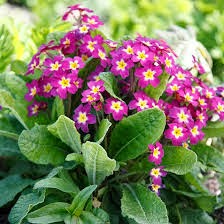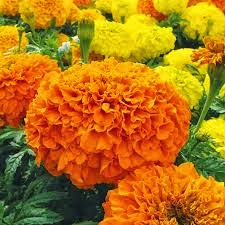You know its Spring when you start to see primroses in bloom along the verges and in woodlands. You can easily transfer this look to your own back garden or make up a brightly coloured pot for Easter.
 Primula vulgaris (primrose) and the many strains of polyanthus primulas will grow happily indoors. However they are happier grown outside in borders or tubs and will flower for longer.
Primula vulgaris (primrose) and the many strains of polyanthus primulas will grow happily indoors. However they are happier grown outside in borders or tubs and will flower for longer.Primulas have a long flowering period from May to December. Early flowering primulas look good planted with other spring flowers such as forget-me-nots (Mytosis), lungworts (pulmonaria), daffadils (narcissi) and grape hyacinths (Muscari). Large flowering polyanthus primulas look good in tubs and when they have finished blooming can be dug up and replanted in the garden to flower again the following year.
Primroses prefer cool temperatures and a rich humus soil so add lots of compost and leaf mould to your soil. As woodland flowering plants primulas appreciate full sun in the spring but they must have partial shade as the summer temperatures wa.
|
Primulas are tolerant of being transplanted, even when in bloom, and new plants can be set into the garden in early spring. Remove the yellow and rotten lower leaves regularly to encourage fresh growth and deadhead regularly removing the rmfaded flower all the way down to the end of the stem.
You can reinvigorate your primulas and encourage a fresh hit of by dead heading the whole patch at the same time. A wash of new flowers will appear within several weeks. Feed with a liquid fertiliser every two weeks.
Most primulas can be propagated by division. Divide and transplant older plants after they are finished blooming. Primula denticulata can be propagated by root cuttings. Cut 5 cm long root sections and lay them horizontally in a box filled with peat and sand then cover with a 1cm layer of the mixture. Place in a cold frame during the winter. New shoots will emerge quickly but do not disturb the plants as rooting will not occur until; the spring. The new plants will flower the following season.
Primulas hybridise easily and planting different strains of primulas together will result in new specimens of different colours the following year. Successive plants bear little resemblance to the original varieties.
You can reinvigorate your primulas and encourage a fresh hit of by dead heading the whole patch at the same time. A wash of new flowers will appear within several weeks. Feed with a liquid fertiliser every two weeks.
Most primulas can be propagated by division. Divide and transplant older plants after they are finished blooming. Primula denticulata can be propagated by root cuttings. Cut 5 cm long root sections and lay them horizontally in a box filled with peat and sand then cover with a 1cm layer of the mixture. Place in a cold frame during the winter. New shoots will emerge quickly but do not disturb the plants as rooting will not occur until; the spring. The new plants will flower the following season.
Primulas hybridise easily and planting different strains of primulas together will result in new specimens of different colours the following year. Successive plants bear little resemblance to the original varieties.
For related articles click onto:
Aphids
Can you keep bees in your garden?
Differences between vegetables and fruit
Drainage
Feeding plants
Growing herbs
Herbaceous borders
How do I attract bees into my garden?
How to build a cold frame
How to grow tulips
How to grow orchids
How to grow primulas
How to grow seeds indoors
How to propagate using division
How to propagate from seed
Patio gardens
Patio Garden Plants
Plants for free
Preparing a seed bed
Shade loving fruit and nuts
Soil structure
What is a loofah?
What is a potager?
What is a vegetable?
What is the difference between a vegetable and a fruit?



















